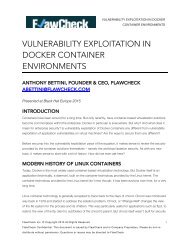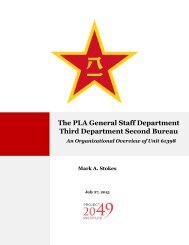3Faces%20of%20the%20Dragon
3Faces%20of%20the%20Dragon
3Faces%20of%20the%20Dragon
Create successful ePaper yourself
Turn your PDF publications into a flip-book with our unique Google optimized e-Paper software.
had come to rely on China for their rare-earth supplies.<br />
The embargo did not work well in the end for China. The stoppages triggered a harsh response<br />
from other nations. Many began to look elsewhere for rare-earth elements and some, like the US and<br />
its Molycorp Minerals LLC at Mountain Pass, California, continued with their plans to restart old<br />
mines. The positive side is found in events such as the recent (8 August 2011) Third China Baotou<br />
Rare-Earth Industry Forum, held on 8 August 2011. One point of discussion was whether China can<br />
enhance further cooperation between itself and foreign companies that also specialize in rare-earth<br />
elements. While China is projected to have 48% of the world’s rare-earth reserves, Baotou has 80<br />
percent of China’s reserves. Meanwhile, China yearly continues to provide 90 percent of the earth’s<br />
rare-earth metals. 894<br />
In 2010, according to one US article, China produced 130,000 tons of rare-earth elements, while<br />
the US produced zero tons. India was second with 2,700 tons, which demonstrates figuratively the<br />
world’s reliance on China. According to the same article, China leads the world with 55 million tons<br />
of rare-earth reserves, with Russia second at 19 million tons and the US third at 13 million tons. 895<br />
Chinese Premier Wen Jiabao stated in October 2010, shortly after the trawler incident, that the nation<br />
will not use rare-earth resources as a bargaining chip, even though most nations had by that time<br />
already made up their minds that China had done so. The China Daily Online attempted to explain<br />
China’s rationale regarding this issue. It noted that rare-earth elements must be cut and prices raised<br />
due to environmental problems that stem from producing 90 percent of the world’s needs and from the<br />
proliferation of small rare-earth companies in China that have allowed the business to sell rare-earth<br />
at very low prices at the expense of added pollution. These two elements, over-exploitation and poor<br />
mining habits, have caused China to reduce the number of companies and set state prices and quotas.<br />
The nation is also implementing restrictions in accordance with laws and regulations. Meanwhile,<br />
other large industrialized nations such as the US are not mining any rare-earth elements and are<br />
thereby saving their reserves for a rainy day. 896 Further, rare-earth elements are used for military<br />
purposes and this is another reason for implementing restrictions on their export. This is a legitimate<br />
security concern of China. Chinese authors such as Jin Gaisong, Vice Director of the International<br />
Trade Department of the Chinese Academy of International Trade and Economic Cooperation, state<br />
that this tactic (limiting sales from Western countries to China for security concerns) has been used<br />
against them repeatedly. 897<br />
According to a report in 2011, the Chinese government is setting rare-earth-element quotas based<br />
on rare-earth output, market demand, and the need for sustainable development. This system is<br />
needed. Between 1996 and 2005 rare-earth exports increased ten times and the price dropped 36<br />
percent. In 2009 China had only 36 percent of the world’s rare-earth reserves, as compared to 43<br />
percent in 1996. Today China is closing hundreds of smaller mines (the Ganzhou production base in<br />
Jiangxi Province once had 1,035 licensed mines) and imposing a 15-20 percent tariff on rare-earth<br />
exports. 898 Prices are skyrocketing. An average ton of rare-earth exports cost $36,297 in January<br />
2011, but by March the price was $68,305. 899 Japan has had to increase the price of its domestically<br />
produced rare-earth magnets, one of its main products, since the prices of neodymium and<br />
dysprosium, the key raw materials in the magnets, have risen sharply over the past few months.










